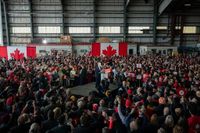Canadians head to the polls today, April 28, 2025, to cast their votes in a snap election that could reshape the nation’s political landscape. Prime Minister Mark Carney, leader of the Liberal Party, is facing off against Conservative leader Pierre Poilievre in what many are calling one of the most consequential elections in Canadian history. The backdrop of this election is the turbulent relationship between Canada and the United States, particularly under the leadership of U.S. President Donald Trump, who has initiated a trade war that has sparked outrage among Canadians.
Before Carney took the helm, the Conservative Party had a commanding lead of 25 points over the Liberals. However, the political tide has shifted dramatically in recent weeks, with Carney’s Liberals now polling at nearly 43%, just ahead of the Conservatives at 39%. This remarkable comeback has been fueled by a surge of Canadian nationalism and a backlash against Trump’s aggressive trade policies, including threats to annex Canada as the “51st state.”
The election was called by Carney on March 23, 2025, shortly after he replaced Justin Trudeau as Liberal leader. As the country prepares to vote, the Liberal Party, which currently holds a minority government with 153 seats in the House of Commons, is projected to win a substantial number of seats, potentially securing a majority.
In a recent poll conducted by Ipsos, a significant number of Canadians expressed confidence in Carney's ability to handle Trump’s tariffs and trade negotiations. Many Canadians are unhappy with Trump’s actions, which have led to widespread boycotts of American goods and public displays of discontent, such as booing the U.S. national anthem at sporting events. Carney’s strong stance against Trump has resonated with voters, as he vowed, “We will never, in any shape or form, be part of the U.S.”
Trump's trade war has imposed unprecedented tariffs on key Canadian industries, including a 25% levy on autos, aluminum, and steel. These tariffs have raised concerns about potential layoffs and factory closures in Canada, prompting both candidates to promise a tough response. Carney has committed to retaliatory tariffs, while Poilievre argues that such measures are essential to deter further attacks from Trump.
As the election approaches, the political landscape has become increasingly polarized. Carney’s campaign has emphasized the need for Canada to strengthen its economy by lowering trade barriers between provinces, a move that could significantly boost interprovincial trade. Currently, trade barriers within Canada are surprisingly high, and estimates suggest that increasing this trade could contribute between 3% to 20% to Canada’s GDP.
Interestingly, Canada has a trade surplus with the U.S., but the U.S. holds a trade surplus with Canada when energy exports are excluded. This complex economic relationship underscores the leverage Canada has in negotiations, particularly regarding energy exports, which account for a substantial portion of trade with the U.S.
In the final days of the campaign, the Conservative Party has chipped away at the Liberal lead, with recent polling showing the Liberals at 41% and the Conservatives closing in at 39%. This tightening race has intensified the focus on which party can best navigate the challenges posed by the U.S. administration.
Both candidates have been vocal about their strategies for dealing with Trump. Carney’s plan includes diversifying Canada’s trade partnerships, particularly with Europe, while also proposing the creation of a domestic manufacturing network to reduce reliance on U.S. imports. Poilievre has pushed for building pipelines to enhance energy exports to Europe, aiming to lessen Canada’s dependence on the U.S. market.
The political discourse surrounding climate change also plays a significant role in the election. While Carney is known for his commitment to climate policy and has been a leading voice in green finance, the divide among Canadian voters on this issue is stark. In Quebec, 84% of residents view climate change as a critical issue, while only 55% in Alberta share this concern. Overall, 60% of Canadians prioritize the cost of living crisis over climate issues, reflecting a complex interplay of economic and environmental interests.
As Canadians prepare to cast their votes, the stakes could not be higher. The outcome of this election will not only determine the next government but also set the course for Canada’s future relationship with the United States. With early voting numbers already exceeding 7 million, the anticipation surrounding the election is palpable.
As the polls close across the country, results are expected to start rolling in after 9:30 p.m. ET, particularly from populous provinces like Quebec and Ontario. Canadian political analysts predict that the election will likely yield a strong majority for the Liberals, with projections suggesting they could secure between 161 to 204 seats in Parliament.
In the wake of Trump’s aggressive stance, the Canadian electorate appears to be rallying around Carney’s leadership, viewing him as a stabilizing force amid uncertainty. The election results will reveal whether Canadians have embraced this new direction or if they will revert to the Conservative policies led by Poilievre, who has been labeled a “Maple MAGA” figure by the Liberals.
Ultimately, the 2025 Canadian election is not just about choosing a government; it’s a referendum on national identity, economic resilience, and the future of Canada’s sovereignty in a world increasingly influenced by American politics.





